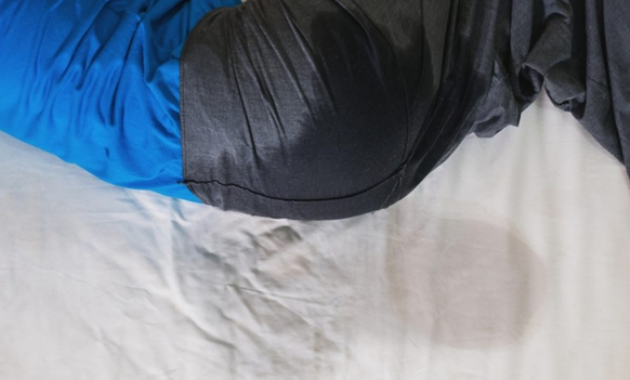Ngompol Saat tidur pertanda Apa? Mungkin kalian banyak yang bingung dan bertanya-tanya tentang hal ini. Dan kali ini, kita akan merambah ke dalam satu fenomena yang mungkin pernah dialami oleh banyak dari kita, yaitu ngompol saat tidur. Mungkin terdengar memalukan atau lucu, tapi siapa sangka, fenomena ini juga bisa membawa pesan dan tafsiran tertentu dari dunia mimpi. Yuk, kita kupas bersama-sama dalam pandangan para ahlinya.
Tentu saja, satu penyebab umum mengompol adalah minum terlalu banyak sebelum tidur, terutama bagi para buah hati. Tapi, tahukah kamu bahwa ada berbagai faktor lain yang bisa memicu aktivitas satu ini? Misalnya, ketakutan atau kecemasan yang melanda pikiran seseorang, bisa jadi memunculkan keinginan untuk buang air kecil di saat-saat yang kurang diinginkan. Jadi, mengompol bisa menjadi ekspresi tubuh terhadap ketegangan emosional.
Mengompol yang dialami oleh orang dewasa sebenarnya bisa menjadi indikator dari kondisi kesehatan tertentu, lho! Ini bisa menjadi semacam alarm tubuh bahwa ada sesuatu yang perlu diperhatikan. Beberapa gangguan kesehatan seperti sleep apnea atau diabetes dapat termanifestasi melalui kecenderungan mengompol pada orang dewasa. Jadi, jangan pernah meremehkan pesan tubuhmu, ya!
Mengompol pada orang dewasa juga bisa menjadi refleksi dari hasrat dan ketegangan emosional yang terpendam. Ketika pikiran dan tubuh tidak bisa menyatu dalam kedamaian, maka seringkali muncul manifestasi fisik seperti mengompol. Hal ini bisa menjadi isyarat bahwa ada masalah atau tekanan yang perlu diatasi agar pikiran dan tubuh bisa bersinergi dalam keharmonisan.
Ketika membahas mengompol, jangan hanya terpaku pada jumlah minuman yang diminum sebelum tidur. Perhatikan juga konteks kehidupan sehari-hari. Apakah ada perubahan signifikan dalam rutinitas atau tekanan emosional baru-baru ini? Ini bisa menjadi petunjuk penting untuk memahami penyebab sebenarnya dari fenomena mengompol.
Mengapa Kita Bisa Ngompol Saat Tidur?
Sebelum kita masuk ke dalam dunia mimpi, penting untuk memahami mengapa seseorang bisa ngompol saat tidur dalam kehidupan nyata. Ngompol saat tidur umumnya terjadi karena kegagalan kontrol kandung kemih selama tidur. Beberapa faktor yang bisa mempengaruhi hal ini termasuk:
- Kondisi Medis: Beberapa kondisi medis, seperti infeksi saluran kemih atau gangguan kandung kemih, bisa mempengaruhi kontrol buang air kecil selama tidur.
- Stres atau Kecemasan: Kondisi emosional seperti stres atau kecemasan juga dapat berkontribusi pada kejadian ngompol saat tidur. Gangguan tidur dan mimpi yang intens bisa menjadi reaksi tubuh terhadap ketegangan emosional.
- Kurangnya Hormon Antidiuretik: Hormon antidiuretik berperan dalam mengatur produksi urine. Pada beberapa kasus, produksi hormon ini mungkin tidak efisien selama tidur, meningkatkan risiko ngompol.
Ngompol Saat Tidur: Pertanda Apa?
Mengompol sebenarnya adalah pesan tubuh yang harus diindahkan. Baik itu pada anak-anak maupun orang dewasa, tubuh memberikan isyarat bahwa sesuatu mungkin tidak berjalan sesuai rencana. Jangan abaikan pesan tersebut. Berbicaralah dengan dokter jika mengompol terus berlanjut atau terkait dengan masalah kesehatan tertentu. Ini adalah langkah awal yang bijaksana untuk menjaga kesehatan pikiran dan tubuh kita.
Pandangan Menurut Islam
Dalam Islam, ngompol saat tidur tidak selalu dianggap sebagai mimpi, tetapi lebih sebagai pengalaman nyata. Islam mengajarkan untuk menjaga kebersihan dan memperlakukan tubuh dengan baik. Jika ngompol terjadi, Islam menekankan perlunya berwudhu dan membersihkan diri sebelum melanjutkan ibadah. Selain itu, bisa menjadi tanda untuk memperhatikan kesehatan dan menjaga kebersihan fisik.
Primbon Jawa: Simbolisme Lokal
Menurut Primbon Jawa, ngompol dalam mimpi dapat memiliki makna tertentu. Ini mungkin diartikan sebagai pertanda akan adanya perubahan atau kejadian yang tak terduga dalam kehidupan. Orang Jawa cenderung melihat mimpi sebagai pesan dari alam gaib yang memberikan petunjuk bagi arah hidup seseorang.
Psikologi: Melihat dari Segi Mental dan Emosional
Dari perspektif psikologi, ngompol saat tidur bisa mencerminkan ketegangan emosional atau stres yang dialami oleh seseorang. Bisa jadi, ini adalah cara tak sadar tubuh mengekspresikan tekanan yang dirasakan. Analisis psikologis dapat membantu seseorang menjelajahi akar masalah yang mungkin memengaruhi keadaan mental dan emosionalnya.
Ngompol dalam Mimpi: Apa Pesan di Baliknya?
Sekarang, mari kita telusuri dunia mimpi dan coba memahami pertanda apa yang bisa diartikan ketika ngompol saat tidur.
Tafsiran 1: Menghadapi Keterbatasan dan Kerentanan
Ngompol dalam mimpi bisa diartikan sebagai simbol dari pengakuan keterbatasan dan kerentanan. Ini mungkin mencerminkan rasa takut atau perasaan tidak mampu mengatasi situasi tertentu dalam kehidupan nyata.
Tafsiran 2: Mengatasi Rasa Malu atau Kekurangan
Jika dalam mimpi kita merasa malu atau merasa rendah diri karena ngompol, ini bisa mencerminkan perasaan serupa yang mungkin kita alami dalam kehidupan nyata. Mimpi ini bisa menjadi isyarat untuk mengatasi rasa malu atau kekurangan yang kita rasakan.
Tafsiran 3: Proses Pembersihan Emosional
Ngompol dalam mimpi juga bisa diartikan sebagai proses pembersihan emosional. Seperti tubuh membersihkan diri dari zat sisa melalui urine, mimpi ini bisa mencerminkan keinginan bawah sadar untuk membersihkan pikiran atau perasaan yang mungkin kita tahan.
Tafsiran 4: Ekspresi Kecemasan atau Stres
Mimpi ngompol juga bisa mencerminkan tingkat kecemasan atau stres yang kita alami dalam hidup nyata. Emosi-emosi ini bisa muncul dalam mimpi sebagai cara alam bawah sadar kita untuk mengatasi atau menyampaikan kegelisahan.
Tafsiran 5: Penerimaan Diri dan Keadaan
Jika dalam mimpi kita ngompol tanpa perasaan malu atau kekurangan, ini bisa mencerminkan penerimaan diri dan keadaan. Mimpi ini mungkin menjadi simbol bahwa meski menghadapi tantangan atau ketidaksempurnaan, kita bisa menerima diri sendiri dengan damai.
Tafsiran 6: Menghadapi Kesalahan atau Kegagalan
Mimpi ngompol bisa diartikan sebagai cara bawah sadar kita untuk menghadapi kesalahan atau kegagalan dalam hidup. Ini bisa menjadi panggilan untuk meresapi pengalaman tersebut, belajar dari kesalahan, dan melanjutkan perjalanan dengan kepala tegak.
Tafsiran 7: Mengatasi Masalah Kesehatan atau Kekhawatiran
Jika ngompol dalam mimpi dihubungkan dengan masalah kesehatan atau kekhawatiran terkait kesehatan, ini bisa menjadi isyarat bahwa alam bawah sadar kita mencoba untuk menyampaikan perhatian terhadap tubuh dan kesehatan kita.
Tafsiran 8: Mengungkapkan Emosi yang Terpendam
Mimpi ngompol bisa menjadi cara bawah sadar kita untuk mengungkapkan emosi yang terpendam atau tidak terungkapkan. Ini bisa terkait dengan perasaan yang mungkin kita tahan atau sembunyikan dari diri sendiri.
Tafsiran 9: Proses Penyembuhan dan Pertumbuhan Pribadi
Ngompol dalam mimpi juga bisa diartikan sebagai bagian dari proses penyembuhan dan pertumbuhan pribadi. Ini mungkin mencerminkan langkah-langkah yang diambil untuk mengatasi tantangan atau kesulitan, dan dengan demikian, tumbuh menjadi versi yang lebih baik dari diri kita.
Tafsiran 10: Menerima Bantuan dan Dukungan
Jika dalam mimpi kita mendapatkan bantuan atau dukungan setelah ngompol, ini bisa menjadi isyarat bahwa alam bawah sadar kita mengakui pentingnya menerima bantuan atau dukungan dalam mengatasi masalah atau rintangan.
Tafsiran 11: Memahami Kehendak dan Kontrol Diri
Ngompol dalam mimpi juga bisa menjadi panggilan untuk memahami kehendak dan kontrol diri. Ini mungkin mencerminkan kebutuhan untuk lebih memahami dan mengelola aspek-aspek dalam hidup yang mungkin kita rasa sulit dikendalikan.
Tafsiran 12: Menyeimbangkan Emosi dan Realitas
Jika ngompol dalam mimpi diikuti dengan upaya untuk membersihkan atau menyeimbangkan situasi, ini bisa mencerminkan keinginan untuk menyeimbangkan emosi dan realitas dalam kehidupan nyata. Mimpi ini mungkin menjadi isyarat untuk mencari harmoni.
Tafsiran 13: Pertanda Perubahan atau Transformasi
Ngompol dalam mimpi juga bisa diartikan sebagai pertanda perubahan atau transformasi. Ini bisa mencerminkan fase baru dalam kehidupan, di mana kita melepaskan beban lama atau mengalami perubahan signifikan.
Penutup: Meresapi Pesan Dalam dan Luar Mimpi
Ngompol saat tidur mungkin merupakan pengalaman yang menyenangkan atau malu dalam kehidupan nyata, tapi dalam dunia mimpi, ia bisa menjadi bahasa bawah sadar kita. Penting untuk diingat bahwa tafsiran mimpi bersifat pribadi, dan setiap orang mungkin memiliki interpretasi yang berbeda-beda. Selamat mengeksplorasi dan meresapi pesan-pesan dalam dan luar mimpi kamu! Ingatlah, dunia mimpi adalah cermin batin yang menunggu untuk ditemukan.
Lihat Juga:
- Kenapa Kita Mimpi Sampai Menangis? Ini Arti dan Tafsirnya
- Arti Mimpi Buang Air Besar Dan Melihat Kotoran Sendiri Pertanda Dapat Rezeki Nomplok?
- Arti Mimpi Buang Air Kecil (Pipis) Sampai Jadi Kenyataan
- 20+ Arti Mimpi Sedang Sholat Menurut Islam, Primbon Jawa dan Psikologi
- Arti Mimpi Sedang Mandi : Pesan Positif dan Negatif Bagi yang Memimpikannya


